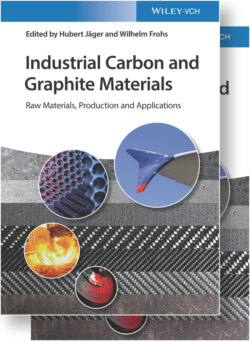Читать книгу Industrial Carbon and Graphite Materials - Группа авторов - Страница 263
6.1.1.1.2 Coal‐Tar Pitch Coke
ОглавлениеCTP coke is made from coal tar after its distillation to a soft pitch. If subsequent coking is performed in a delayed coker, a CTP needle coke can be obtained. Coking in a chamber furnace gives more isotropic coke types, particularly if the feed is air‐blown in advance. These coke types are of greater hardness and strength than the petroleum cokes.
Currently produced CTP needle cokes are of competitive quality in CTE and graphitizability compared with petroleum‐derived coke. Their main disadvantage is the irreversible expansion phenomenon driven by the release of nitrogen during the graphitization of the electrode during its manufacture. The difference in this so‐called puffing between a petroleum‐based coke and a CTP‐based coke is shown in Figure 6.1.1.6. Most critical is the expansion velocity in the temperature regime between 2000 and 2300 K. This problem (so‐called nitrogen puffing) has not been solved on an industrial scale for the fast lengthwise graphitization technology with the consequence that this type of coke is mostly used in old Acheson graphitization furnaces, which require long temperature cycles.
Modern Western world lengthwise graphitization Castner furnaces are running at short temperature heating cycles (<16 hours), which have been adjusted to petroleum needle coke. The prevention of nitrogen puffing would make CTP needle coke technically fully competitive to petroleum needle coke. The estimated annual global capacity of CTP needle coke is at about 500 000 t with the tendency to exceed the petroleum needle coke production in the future (Figure 6.1.1.7). The puffing phenomenon had attracted research from academia and industry from the past until today [13–19]. A comprehensive review on the puffing phenomenon had been given recently [20, 21].
Depending on the coker feed (ash content) and coking conditions, semi‐isotropic and isotropic CTP cokes are produced. Isotropic coke grades are used in special fine‐grained graphite products. They are also of interest for their application in graphite‐moderated nuclear power plants. For this application low boron and vanadium contents are the main criteria. A certain amount of this coke goes into anode and blast furnace lining manufacturing.
Figure 6.1.1.6 Expansion of petroleum and coal‐tar pitch coke‐derived electrodes during graphitization [22].
Figure 6.1.1.7 Estimated petroleum and coal‐tar pitch needle coke capacities [22].
